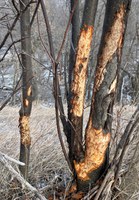Dakota Gardener: A walk in the woods
(Click an image below to view a high-resolution image that can be downloaded)
By Joe Zeleznik, Forester
NDSU Extension
I took a walk in the woods last week with a colleague of mine, along with some graduate students. We were at Knife River Indian Villages National Historic Site. Have you ever been there? It’s a fascinating place.
Of course, to me, any forest is fascinating.
What is a forest, anyway? It’s a simple question, but the answer isn’t quite so easy. This is actually how I start out my introductory forestry class each time that it’s taught. What’s a forest? Is it just a bunch of trees? If yes, how many? There are dozens of definitions of “forest,” and though many of them are similar, some are very unique.
The definition that we use in class is that a forest is “an ecosystem dominated by trees, but also consisting of associated flora and fauna, covering a considerable area.” An ecosystem dominated by trees. I like that phrase, because it states very simply what makes a forest unique – trees are the main component. Yes, there are shrubs and grasses and forbs – associated flora. Yes, there are deer and insects and birds – associated fauna. But the main component of a forest is the trees.
Admittedly, the phrase “covering a considerable area” is rather vague. Certainly 50 acres is considerable. How about 10 acres? Or even one acre? Is a single-row shelterbelt considered “considerable?”
None of the standard definitions of forest agree on how big a tree-dominated ecosystem must be to be a forest. Some definitions say five acres while another says 10. One of the definitions lists only a single acre as being necessary to be considered as a forest. So, we leave that part of the definition vague. The area must be “considerable.”
The specific forest we walked through at Knife River is about 80 acres. It’s considerable.
I looked up at the forest canopy, the collection of individual tree crowns that consist of branches, and during summer, the leaves that produce food during photosynthesis. At Knife River, this particular canopy was in rough shape, having been damaged repeatedly by wind storms in recent years. There was a lot of debris on the forest floor.
I looked down, trying to find new tree seedlings coming up. There were very few, and those that managed to establish showed signs of being browsed by deer. This forest serves as a deer yard in winter, providing shelter from temperature extremes and howling winds. But the hungry animals also nip at any food that the forest might provide. It’s a tough place for trees.
While I look at the trees and the shrubs, my colleague Shawn looks at the herbaceous plants, the ones that don’t have woody stems or roots. This includes grasses, sedges, wildflowers and other forbs. Even in winter, he was able to identify a number of plants. The guy is amazing.
Unfortunately, many of the plants he identified were non-native, invasive species, including brome grass and dame’s rocket. The brome grass makes it hard for new trees to establish. It forms a dense canopy of its own, shading the soil and taking up any available moisture.
We took our walk in the woods to help us come up with ideas on how to regenerate the forest. The park managers want to establish new trees and we want to figure out how to best do that, even with all the challenges this site presents. We’re actually pretty excited about the project, but I have to admit that I’m a bit apprehensive at the same time. It won’t be easy.
Nevertheless, we’ll give it our best shot. And we’ll continue to walk in the woods, and observe, and learn. Have you taken a walk in the woods this winter? What have you seen?
By the way, is a single-row shelterbelt considered a forest? Actually, no. According to the U.S. Department of Agriculture Forest Service, for a shelterbelt to be considered a forest, it must be at least 120 feet wide, 360 feet long, and cover at least one acre. Is that “considerable?”
NDSU Agriculture Communication – Feb. 20, 2024
Source: Joe Zeleznik, 701-730-3389, joseph.zeleznik@ndsu.edu
Editor: Kelli Anderson, 701-231-7006, kelli.c.anderson@ndsu.edu




